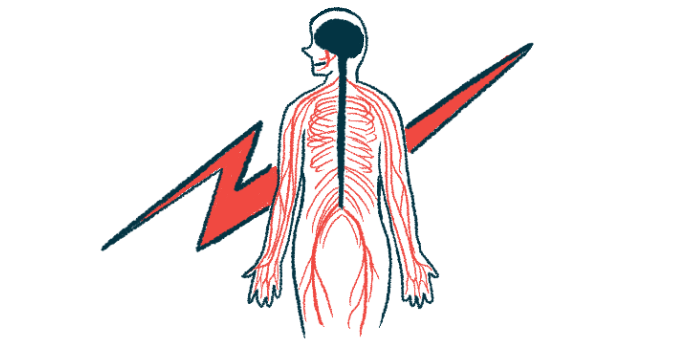Neuropathy linked with TTR mutation V142I: Study
Nerve pain, cardiac symptoms could overlap, researchers say

Neuropathy, or nerve-related pain, is more prevalent than previously reported in people with the V142I mutation of hereditary transthyretin amyloidosis (ATTRv), a study found.
Familial amyloid polyneuropathy (FAP), a clinical form of ATTRv, typically involves progressive nerve damage.
V142I, the most common ATTRv mutation in the U.S., has traditionally been associated with cardiac symptoms. This research shows that many carriers also have signs of peripheral neuropathy, such as sensory loss, weakness, and reduced reflexes. The study highlights that V142I can show overlapping cardiac and neurological features, emphasizing the need for broader clinical awareness beyond cardiomyopathy alone.
The study, “Peripheral Nervous System Involvement of Hereditary Transthyretin Amyloidosis in the United States: A Multi-Center Perspective,” was published in Muscle & Nerve.
Typically in ATTRv, mutations in the TTR gene cause abnormal transthyretin proteins to misfold and accumulate as toxic amyloid deposits in various tissues. Some mutations are strongly linked to amyloid buildup in peripheral nerves, leading to neuropathy — nerve damage that can cause FAP symptoms such as muscle weakness, numbness, and pain.
Other mutations, like V142I, are more commonly associated with amyloid deposition in the heart. This results in cardiomyopathy, a condition that weakens the heart muscle and impairs its ability to pump blood effectively, which can eventually lead to heart failure.
Understanding mutation key to personalized care
Because of the variability of mutations and symptoms, “understanding the specific mutation an individual carries is crucial for personalized management and treatment decisions, particularly in populations with a higher risk of carrying that mutation,” the researchers wrote.
A deeper knowledge of symptoms associated with different mutations, or genotypes, can also help with early FAP diagnosis. This is important because early treatment can help prevent the disease from progressing to more severe forms.
“There is a need to enhance our understanding of the initial and multisystem red flag indicators of ATTRv and it is crucial that healthcare professionals who may encounter these patients are knowledgeable regarding these indicators,” the researchers wrote.
The team assessed different types of symptoms in 76 ATTRv patients, 58 of whom had the V142I mutation. All were patients at one of three U.S. centers from 2018 to 2022. The team also recruited 26 controls who were assessed for neuropathy that was likely unrelated to TTR.
Demographics differed significantly among V142I participants, non-V142I ATTRv participants, and controls. The group with V142I mutations was older, with a median age of 68, compared with 59 in other ATTRv participants and 55 in controls. They were also primarily African American (86%) and were more likely to have diabetes (40%).
Because diabetes is a common cause of neuropathy, the research team specifically evaluated patients whose symptoms appeared more severe or atypical than expected for diabetic neuropathy alone.
Prevalence of cardiomyopathy and symptoms of neuropathy were similar between the two ATTRv groups. For both, the most common symptom of nerve damage was abnormal sensitivity to pinpricks and loss of temperature sensation. This occurred in 74% of the V142I group and 83% of the ATTRv group with other mutations. Other common neuropathic symptoms included weakness, loss of sensitivity to vibrations, pain, and gastrointestinal (GI) problems.
When available, the research team reviewed nerve conduction studies, which assess the presence and type of nerve damage. Nearly all V142I participants (98%) who underwent these tests showed abnormalities. Axonal polyneuropathy, which results from damage to the long fibers of nerve cells across multiple nerves, was the most common diagnosis, occurring in 81% of V142I participants.
Median mononeuropathy, nerve damage affecting the median nerve in the wrist which commonly causes carpal tunnel syndrome, was relatively common across all ATTRv groups. However, the proportion of individuals with severe median mononeuropathy on the right side (typically the dominant hand) was significantly higher in the V142I group compared with those with other mutations.
“The findings presented here carry clinical relevance, as they underscore the necessity of increasing physician awareness of the broad spectrum of cardiac, GI, autonomic, and neuropathic symptoms associated with ATTRv amyloidosis, regardless of TTR genotype, to mitigate diagnostic delays of this rapidly progressive disease,” the researchers wrote.
The team suggested physicians should suspect V142I mutations in patients, particularly African American patients, who show potential neuropathy. “A low threshold for neurology referral and electrodiagnostic studies [such as nerve conduction studies] in at-risk populations is encouraged,” they wrote.
The team also recommended further studies in larger groups of people with V142I mutations, including assessment of how medications affect symptoms.







